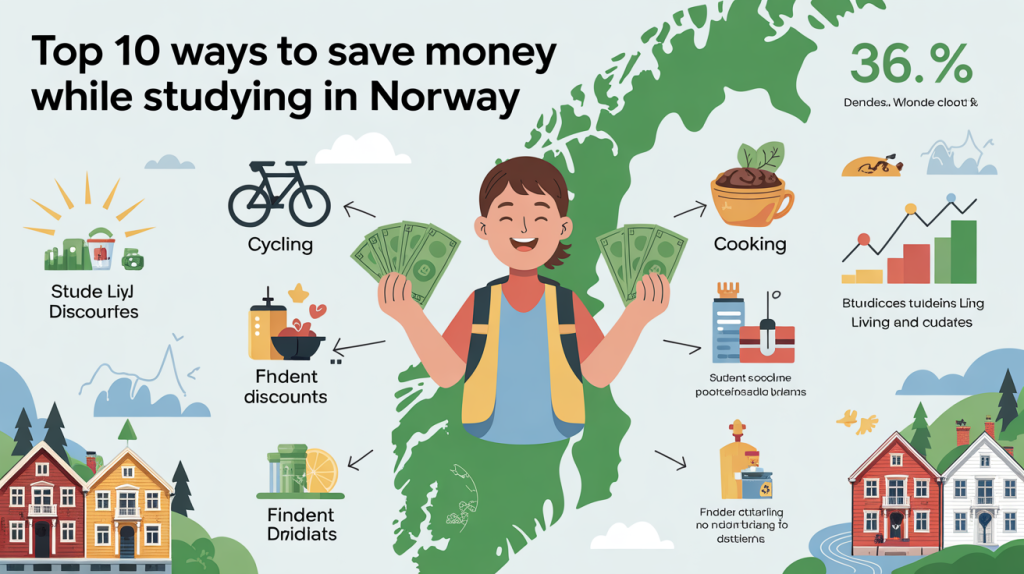Top 10 Ways to Save Money While Studying in Norway
- 1. Apply for Scholarships and Financial Aid
- 2. Choose Affordable Accommodation
- 3. Cook at Home and Pack Lunches
- 4. Use Student Discounts
- 5. Use Public Transportation
- 6. Look for Part-Time Work
- 7. Buy Second-Hand Books and Supplies
- 8. Enjoy Free Outdoor Activities
- 9. Shop Smart for Groceries
- 10. Budget and Track Spending
- Take the Next Step with Study in Norway
1. Apply for Scholarships and Financial Aid
One of the most effective ways to reduce the financial burden is by securing scholarships and financial aid. Many Norwegian universities provide scholarships based on academic merit and financial need. Additionally, the Norwegian government and other organizations offer scholarships for select countries and study programs.
Action points:
- Encourage students to research all scholarship options early.
- Highlight deadlines and application requirements clearly.
- Use tools like Study in Norway to identify relevant funding opportunities.
2. Choose Affordable Accommodation
Accommodation costs often comprise the largest part of living expenses for students. University dormitories or shared apartments generally offer more affordable options compared to private rentals.
Key tips:
- Advise students to apply for student housing as soon as possible.
- Promote shared living arrangements which also facilitate social connections.
- Point students to resources on student housing options and affordable living arrangements.
3. Cook at Home and Pack Lunches
Norwegian restaurants and cafés tend to be pricey. Preparing meals at home or packing a matpakke—the traditional Norwegian packed lunch—is an excellent way to control daily food expenses.
Practical advice:
- Share cooking tips for quick, nutritious meals suitable for international tastes.
- Recommend local supermarkets and budget-friendly grocery stores.
- Encourage students to embrace Norwegian food culture through affordable homemade meals.
4. Use Student Discounts
Norway offers a range of student discounts on public transportation, museums, shops, and eating establishments. Students should always carry their valid student ID and inquire about available discounts.
Implementation strategies:
- Provide comprehensive lists of where student discounts apply.
- Integrate discount awareness campaigns into orientation programs.
- Promote the use of digital student cards for convenience.
5. Use Public Transportation
Public transportation is reliable, environmentally friendly, and often subsidized for students. Discounted travel passes for buses, trams, and trains help students commute affordably within cities and beyond.
Recommendations:
- Inform students about regional and national travel discounts.
- Suggest monthly or semester passes to maximize savings.
- Highlight eco-friendly transport options aligning with Norway’s sustainability goals.
6. Look for Part-Time Work
Norwegian regulations allow international students to work part-time up to 20 hours per week during semesters and full-time during holidays. This income can significantly support living costs.
Guidance for students:
- Assist with job search resources and work permit information.
- Encourage employment in flexible roles compatible with study schedules.
- Emphasize the balance between work and study for academic success.
7. Buy Second-Hand Books and Supplies
Academic materials, including textbooks, can be costly in Norway. Buying used books through university libraries, student groups, or second-hand shops reduces expenses efficiently.
Actionable tips:
- Build awareness of book exchange programs and online marketplaces.
- Promote digital textbooks and resources as economical alternatives.
- Share tips on organizing study groups to share materials.
8. Enjoy Free Outdoor Activities
Norway’s stunning natural landscapes offer plenty of no-cost recreational activities, such as hiking, swimming, and skiing. These not only provide affordable leisure options but also promote health and social engagement.
Suggestions:
- Curate guides to free local outdoor activities near university campuses.
- Organize group outings to facilitate community building.
- Highlight seasonal events and natural attractions accessible to students.
9. Shop Smart for Groceries
Groceries can be expensive, but students can save by shopping at budget supermarkets, watching for sales, and choosing generic brands. Some even make occasional trips across borders (e.g., Sweden) for cheaper options, abiding by customs regulations.
Savvy shopping strategies:
- Encourage meal planning to reduce waste and optimize spending.
- Identify local discount stores and markets.
- Educate about Norwegian food labeling and pricing to make informed choices.
10. Budget and Track Spending
Finally, diligent budgeting is essential for successful money management. Tracking expenses using simple tools or apps helps students stay within their financial limits and avoid unexpected shortages.
Budgeting best practices:
- Promote financial literacy workshops for incoming students.
- Recommend user-friendly digital tools to monitor expenditures.
- Encourage regular review of budgets and adjustments as needed.
Take the Next Step with Study in Norway
If you are an international recruiter, university admissions team, or education professional seeking to enhance your recruitment strategies and provide unparalleled support to students interested in Norway, Study in Norway is your trusted partner.

